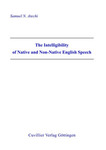World Voice Day

Zum World Voice Day möchten wir euch spannende Forschung aus unserem Verlag vorstellen.
Intonational Meaning in Cameroon English Discourse
A Sociolinguistic Perspective
Intonation has been demonstrated to be one of the linguistic components which set the native speaker of a language like English apart from the non-native speaker or the learner of that language (Jilka, 1999, 2000). This clearly suggests that each non-native variety of English displays its intonation systems which make it somewhat sui generis and different from other varieties of English.
A lot of research has been conducted on prosodic or intonational variation in both native varieties of English (e.g. Brend, 1972; Pellowe and Jones, 1978; Fletcher and Harrington, 2001) and non-native English varieties (e.g. Gut, 2003; Udofot, 2000, 2003) and has pictured the extent to which prosodic or intonational features vary with respect to independent social variables like education, age, gender, ethnic origin, social class as well as linguistic variables like speaking style. The present study, like those ones, draws on quantitative sociolinguistics or the Labovian sociolinguistic approach also referred to in the literature as secularlinguistics(cf. Trudgill, 2003) to account for intonational variation in Cameroon English (hereinafter CamE).
The purpose of the study is to characterise some features of intonational meaning, namely, tone (Brazil, 1997) and paratone (Crystal, 1969; Brown, 1977; Yule, 1980; Brown and Yule, 1983; Couper-Kuhlen, 1983, 1986; Tench, 1996) as well as the intonational marking of new and given information in CamE and to assess the degree to which they vary in respect of extra-linguistic variables like educational attainment and gender and of the linguistic variable speaking style.
Intonational Meaning in Cameroon English Discourse
Yves Talla Sando Ouafeu▲ nach oben springen
Vergleich von Sprachduktus und Melodik historischer Aufnahmen der Peking-Oper (Band 123)
Außerhalb (und möglicherweise sogar auch schon innerhalb) Chinas existiert die Vorstellung, dass die Gesangsmelodie des traditionellen chinesischen Musiktheaters musikalisch unbefriedigend sei. Eine wichtige Voraussetzung zum Verständnis besteht aber darin, dass der Gesang des traditionellen chinesischen Musiktheaters durch die Sprachmelodie wesentlich mitbestimmt wird und nicht wie in der westlichen Musik motivisch und thematisch bearbeitet wird. Aber in der Tat ist die Melodik nach den vorliegenden Analysen nicht völlig ohne eine Verarbeitung musikalischer Elemente.
Vergleich von Sprachduktus und Melodik historischer Aufnahmen der Peking-Oper (Volume 123)
Shu-Jiuan Lu▲ nach oben springen
The Intelligibility of Native and Non-Native English Speech
With the emergence of non-native varieties of English across the globe, the concept of intelligibility has attracted the attention of many scholars. However, the majority of major works on the concept were carried out some decades ago (see Bansal 1969; Tiffen 1974).
The purpose of this study is to measure the intelligibility of Cameroon English speech to British and American English speakers and vice versa, and to analyse the major causes of intelligibility failure when speakers of these varieties of English interact. Focus is on segmental and supra-segmental phonology. The study was motivated by a number of concerns: the trepidation nursed by some scholars that the emergence of non-native varieties around the world would cause English to disintegrate into mutually unintelligible varieties in the way Romance languages devolved from their Latin ancestors; the fact that previous studies on intelligibility were centred on the traditional approach which considers non-native varieties of English to be deficient, and not different from native varieties and the debate on the level of phonological analysis that is considered the greatest threat to intelligibility between native and non-native speakers.
The Intelligibility of Native and Non-Native English Speech
Samuel N. Atechi▲ nach oben springen
Trainable Text-to-Speech Synthesis for European Portuguese
This dissertation implements a hidden Markov models (HMM) based text-to-speech (TTS) synthesis system for European Portuguese (EP).
The work describes the different speech synthesis approaches and overviews the use of HMMs in speech synthesis. The history of HMMs in speech synthesis is outlined, the main techniques used to apply HMMs to speech synthesis are explained and the speech parameter generation algorithm is described.
To improve the results, a speech corpus especially designed for context-based EP TTS systems is proposed and a subset of the complete corpus, organized in orthographic sentences together with their phonetic transcription are presented in the dissertation. Two other improvements to the system are suggested: a hybrid system based on the residual signal, in substitution for the pulse train used in the source-filter model of the speech synthesizer for the voiced sounds; and a method for dealing with foreign words, based on the mapping of phonemes from EP with phonemes of other languages or dialects.











